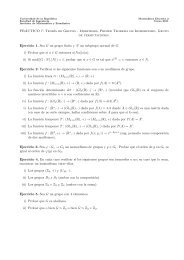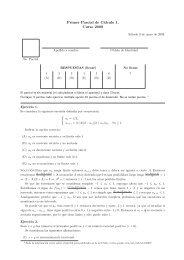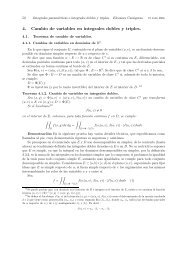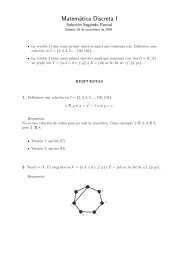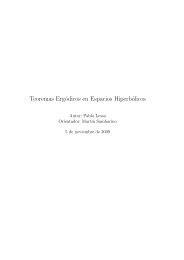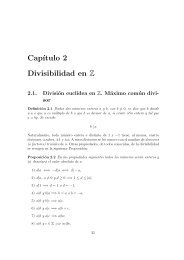Solución Examen de Matemática Discreta II 27 de febrero ... - IMERL
Solución Examen de Matemática Discreta II 27 de febrero ... - IMERL
Solución Examen de Matemática Discreta II 27 de febrero ... - IMERL
You also want an ePaper? Increase the reach of your titles
YUMPU automatically turns print PDFs into web optimized ePapers that Google loves.
1. (30 puntos)<br />
<strong>Solución</strong><br />
<strong>Examen</strong> <strong>de</strong> <strong>Matemática</strong> <strong>Discreta</strong> <strong>II</strong><br />
<strong>27</strong> <strong>de</strong> <strong>febrero</strong> <strong>de</strong> 2008<br />
a) (20 puntos)<br />
Sea s el número <strong>de</strong> salas y c el número <strong>de</strong> cajas <strong>de</strong> 50 baldosas (19 ≤ c ≤ 39). Entonces 50c + 42 =<br />
32s + 20. Luego 25c ≡ −11 mód(16), o sea 9c ≡ −11 mód(16). Como 9 es inverso <strong>de</strong> si mismo en<br />
Z16, se obtiene que c ≡ 13 mód(16). O sea c = 29 y el hospital precisa <strong>de</strong> 1492 baldosas.<br />
b) (10 puntos)<br />
Sea n = 1492 = 2 2 × 373. Entonces ϕ(n) = 2 × 372. Sea m = 1119 = 3 × 373. Luego ϕ(m) = ϕ(n).<br />
2. (35 puntos)<br />
a) (4 puntos)<br />
Los restos cuadráticos en Z ∗ 7 son: { 1, 2, 4 }.<br />
b) (8 puntos)<br />
φ es morfismo:<br />
φ(x.y) = (x.y) 2 = x 2 .y 2 = φ(x).φ(y) (el grupo es abeliano).<br />
Núcleo:<br />
φ(x) = 1 ⇔ [x] 2 ≡ 1 mod(p) ⇔ (x − 1)(x + 1) = ◦ p. Po<strong>de</strong>mos tomar 1 ≤ x ≤ p − 1, con lo cual las<br />
soluciones son: x = 1 o x = p − 1. O sea: N(φ) = {±1}.<br />
c) (12 puntos)<br />
Como H =Im(φ) <strong>de</strong>l punto anterior, entonces H < G y luego H = Im(φ) ∼ = G<br />
N(φ)<br />
d) (6 puntos)<br />
Como el grupo es abeliano todo subgrupo es normal. Como<br />
isomorfo a Z2. La tabla se <strong>de</strong>duce a partir <strong>de</strong> lo anterior.<br />
e) (5 puntos)<br />
Consecuencia directa <strong>de</strong>l punto anterior.<br />
3. (35 puntos)<br />
a) (7 puntos)<br />
Ver teórico <strong>de</strong>l año.<br />
Z ∗<br />
p<br />
H<br />
= Z ∗<br />
p<br />
{±1} .<br />
tiene dos elementos entonces es<br />
b) i. (14 puntos)<br />
Tenemos x1 = y c1<br />
1 .(yc2 2 )−1mod(n) = xe1.c1−e2.c2mod(n). Esto último es x mod(n).<br />
ii. (14 puntos)<br />
Primero calculamos c1 y c2. Tenemos que c1 = <strong>27</strong>−1mod(29) = 14mod(29), y c2 = 14·<strong>27</strong>−1<br />
29 = 13.<br />
Por la parte anterior, x1 = y c1<br />
1 (yc2 2 )−1mod(n) = 998314 · (402613 ) −1mod(16123). Calculemos primero 402613 utilizando el algoritmo <strong>de</strong> exponenciación rápida. 402613 = 402623 +2 2 +1<br />
40262 = 5061mod(16123)<br />
402622 = (40262 ) 2mod(16123) = 50612mod(16123) = 10397mod(16123)<br />
402623 = (402622) 2mod(16123) = 103972mod(16123) = 9017mod(16123)<br />
Entonces, 402613mod(16123) = 402623 +2 2 +1mod(16123) = 9017 · 10397 · 4026mod(16123) =<br />
9983mod(16123).<br />
Observemos entonces que x1 = 998314 · (9983) −1mod(16123) = 998313mod(16123) Calculemos 998313mod(16123) = 998323 +2 2 +1 .<br />
99832 = 4026mod(16123)
998322 = 40262 = 5061mod(16123)<br />
998323 = 402622 = 10397mod(16123)<br />
Entonces, 998313mod(16123) = 998323 +2 2 +1mod(16123) = 10397 · 5061 · 9983mod(16123) =<br />
714mod(16123).<br />
Por lo tanto, x = 714mod(16123).



